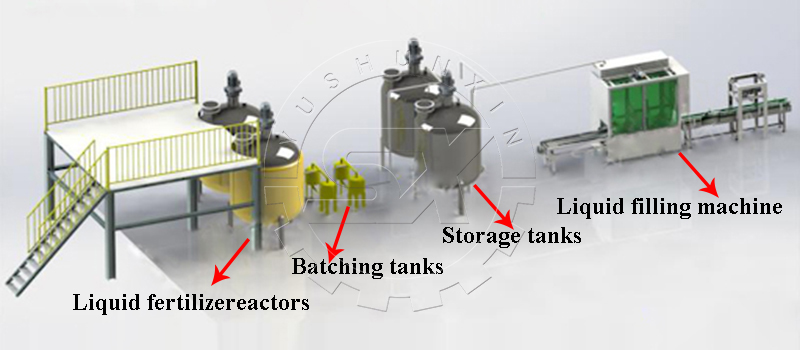Paano Gumawa ng NPK Liquid Fertilizer
Maraming mga tagagawa ng pataba ang nais na mapalawak sa produksiyon ng NPK Liquid Fertilizer dahil sa mabilis nitong pagsipsip ng nutrisyon at malawak na demand sa merkado. Upang makagawa ng NPK Liquid Fertilizer, Ang proseso ng paggawa ay dapat tiyakin ang buong paglusaw ng mga nutrisyon, Tumpak na Batching, at matatag na pagbabalangkas. Kasama sa buong proseso ang pagpili ng hilaw na materyal, awtomatikong dosis, reaksyon at paghahalo, Additive Adjustment, at pagpuno ng produkto. Ang bawat hakbang ay nangangailangan ng maaasahang kagamitan at wastong operasyon upang mapanatili ang pagkakapare -pareho at kahusayan.
Anong mga hilaw na materyales ang angkop para sa NPK likidong pataba?
Upang maghanda ng de-kalidad na pataba na likidong NPK, Ang unang hakbang ay ang pagpili ng tamang mga materyales. Ang mga mapagkukunan ng nitrogen tulad ng urea, ammonium nitrate, o madaling matunaw ang ammonium sulfate sa tubig. Para sa posporus, Phosphoric acid o Monoammonium phosphate (Mapa) ay karaniwang mga pagpipilian. Ang potasa ay karaniwang nagmula sa potassium chloride (KCl) o potassium sulfate (k₂so₄). Maaari kang pumili ng mga pinong pulbos upang matiyak ang mabilis na paglusaw at matatag na paghahalo. Kung plano mong pagbutihin ang mga elemento ng bakas, Micronutrients tulad ng Fe, Zn, Mn, at B ay maaaring maidagdag sa pamamagitan ng chelation o kumplikado.
Anong kagamitan ang kailangan mo upang gumawa ng NPK Liquid Fertilizer?
Ang isang kumpletong linya ng produksiyon ng NPK Liquid Fertilizer ay may kasamang:Awtomatikong sistema ng pag -batch para sa dosis ng sangkap, reaksyon at paghahalo ng mga tangke sa mga agitator at kontrol sa temperatura, Auxiliary material dosing tank para sa mga additives, Mga yunit ng pagsasala upang alisin ang mga impurities, Mga tangke ng imbakan at bomba para sa intermediate transfer, Mga makina ng pagpuno ng likido Para sa panghuling packaging. Para sa daluyan o malakihang mga proyekto ng paggawa ng pataba ng NPK na likido, Ang Awtomatikong Kontrol at Daloy ng PLC ay tumutulong sa pagsubaybay sa bawat hakbang sa paggawa, pagpapabuti ng kawastuhan at kahusayan.
Kunin ang iyong likidong halaman ng pataba
Limang mga hakbang ng proseso ng pagmamanupaktura ng NPK likidong pataba
Ang paggawa ng NPK Liquid Fertilizer May kasamang limang praktikal na hakbang.
Awtomatikong Batching: Una, Dapat mong ihanda nang tumpak ang mga hilaw na materyales sa pamamagitan ng isang awtomatikong sistema ng pag -batch. Masisiguro nito ang paggawa ng iba't ibang mga form na form ng pataba ng NPK, tulad ng 10-10-10 o 20-5-10. Ang katumpakan sa yugtong ito ay ginagarantiyahan ang pare -pareho na konsentrasyon ng nutrisyon sa panghuling produkto.
Pag -aalis at reaksyon: Susunod, Ang mga hilaw na materyales na ito ay pumapasok sa hindi kinakalawang na asero reaksyon tank na may kinokontrol na temperatura at pagkabalisa. Dito, Ang mga reaksyon ng kemikal sa pagitan ng mga acid at base ay naganap, bumubuo ng mga compound na natutunaw ng tubig na NPK. Kasabay nito, Ang wastong paghahalo at pag -aayos ng pH ay pumipigil sa sedimentation at crystallization.
Pagdagdag ng materyal na pandiwang: karagdagan: Matapos ang paghahalo ng likidong NPK, Maaari kang magdagdag ng mga stabilizer, mga ahente ng anti-foaming, o microbial additives sa pamamagitan ng mga auxiliary dosing tank. Ang mga sangkap na ito ay nagpapabuti sa katatagan ng likidong pataba ng NPK, aktibidad ng biyolohikal, at pagganap ng imbakan.
Tapos na imbakan ng produkto: Pagkatapos ng reaksyon at pagsasala, Ang solusyon ay naka -imbak sa puti o hindi kinakalawang na asero tank. Maaari mong subaybayan ang antas ng likido sa pamamagitan ng direktang pagmamasid o paggamit ng isang antas ng sukat.
Liquid pagpuno at packaging: Ang pangwakas na produkto ay dumadaan sa isang likidong pagpuno ng pataba. Pinupuno nito ang mga drums o bote na awtomatikong may tumpak na kontrol sa dami. Bukod dito, Ang mga opsyonal na label at capping system ay tumutulong sa mga prodyuser na maihatid ang handa na ibenta na likidong NPK na mga pataba.
Paano bumili ng isang de-kalidad na NPK likidong paggawa ng pataba?
Kapag pumipili ng kagamitan para sa pagmamanupaktura ng NPK Liquid Fertilizer, Dapat kang tumuon sa kalidad ng materyal, propesyonalismo ng disenyo, at serbisyo pagkatapos ng benta. Mas gusto ang mga makina na gawa sa 304 hindi kinakalawang na asero upang labanan ang kaagnasan mula sa mga materyales at alkali na materyales. Bilang karagdagan, Dapat kang pumili ng isang maaasahang likidong paggawa ng pataba na tagabigay ng makina. Yushunxin, Bilang isang propesyonal na tagagawa ng halaman ng pataba na pataba, Nagbibigay ng turnkey NPK likidong mga linya ng paggawa ng pataba mula sa 1000 L/h to 20 T/h. Kasabay nito, Nag -aalok kami ng buong disenyo ng proseso, Patnubay sa Pag -install, at suporta ng ekstrang bahagi. Maligayang pagdating upang kumunsulta!


